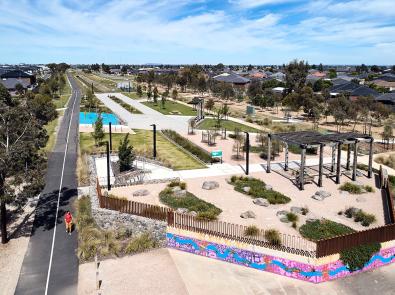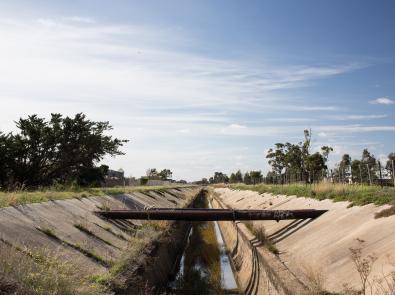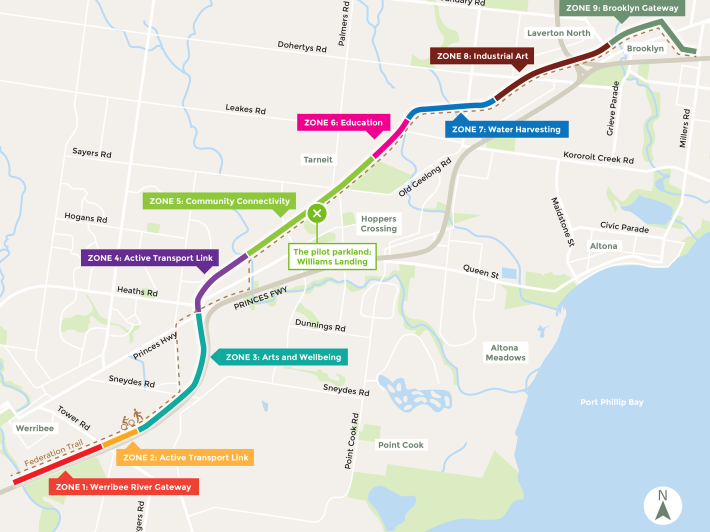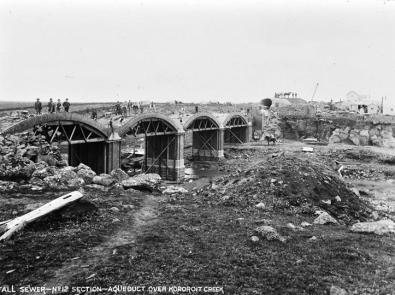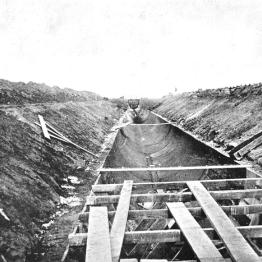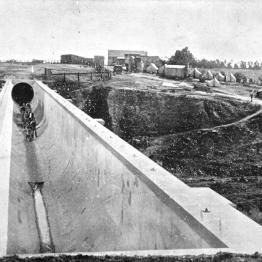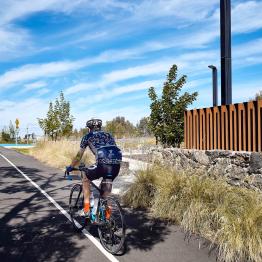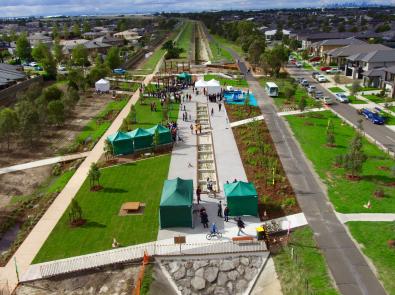The Greening the Pipeline initiative is transforming the Main Outfall Sewer reserve along the Federation Trail in Melbourne's west into a greener, cooler linear parkland and a more enjoyable community space.
Wyndham City Council is leading the delivery of the project in partnership with Melbourne Water, Greater Western Water, Department of Energy, Environment and Climate Action (DEECA), Department of Transport and Planning, Bunurong Land Council Aboriginal Corporation, and is supported by Greening the West.
Why is this project important?
From Werribee to the city, the linear parkland will provide improved active transport links, more trees and shade, and unique community spaces to meet, play, and relax.
The project will create a green corridor along the decommissioned sewer pipeline reserve that:
- connects communities
- creates vibrant open space
- improves community health and wellbeing
- enhances active transport links and green corridors
- improves water quality and how water is managed
- celebrates history and cultural heritage.
Watch the video below to learn more about the project:
What is the Main Outfall Sewer?
The Main Outfall Sewer was built in the 1890s to improve the health of Melbourne. For nearly 100 years, it transferred most of Melbourne’s sewage for treatment in Werribee until 1993 when it was decommissioned. In 2005, VicRoads (now Department of Transport and Planning) built the Federation Trail for cyclists and pedestrians along the Main Outfall Sewer pipeline reserve.
The sewer reserve is 40 metres wide and 27 kilometres long. It runs from the old pumping station in Spotswood (now part of Scienceworks Museum) to the Western Treatment Plant in Werribee.
What’s happening and when?
The 27 kilometre Greening the Pipeline project has been divided into nine zones, with most of the transformation occurring inside the City of Wyndham, and some in the Cities of Brimbank and Hobsons Bay. The planning, design and delivery for each of the different zones is being undertaken in a staged manner.
Project zones
- Werribee River gateway: an inviting space which introduces the start/finish of the pipeline
- Active transport link: to improve access to the pipeline reserve to more residents for walking and cycling
- Arts and wellbeing: a space which supports mental and physical wellbeing
- Active transport link: to open up the pipeline reserve to more residents for walking and cycling
- Community Connectivity: a space that brings the community together and connects existing open spaces
- Education: a space to play and learn
- Water harvesting: to improve water quality
- Industrial art: improving the space for local workers
- Brooklyn gateway: an inviting space which introduces the start/finish of the pipeline
What's been completed so far?
-
Pilot Park
-
Project lead: Melbourne Water
Completed: 2016-2017The very first zone of the project, Pilot Park, was built along 100 metres of the pipeline reserve at Williams Landing in 2016-2017. The park was used as a showcase to demonstrate the potential for creating a green linear parkland along the whole extent of the Federation Trail, and in taking a more holistic approach to water management.
This pilot project was originally initiated in 2013 by Greening The West, City West Water (now Greater Western Water) and Melbourne Water, who were granted Victorian Government funding and identified the site. Shady, vegetated spaces now line the old channel, providing a healthy and enjoyable environment for social engagement and recreational activities in an area that was once divisive and under-utilised.
As a demonstration pilot site for best-practice integrated water management, the park is also fitted with assets to capture, filter and reuse local stormwater to irrigate grass, shrubs and trees. The result is a cooler, more comfortable microclimate and new habitats for native species. Solar lights throughout the park save energy and keep the area active and safe, while a shared-use bicycle and pedestrian path links suburbs from Brooklyn to Werribee, improving liveability and providing physical and mental health benefits.
Thanks to the success of the Greening the Pipeline collaborations, the plan is to transform the entire length of the Main Outfall Sewer pipeline reserve into a world-class linear park. Once completed, this 27 kilometre green active transport corridor will represent a project of regional significance, connecting communities of Melbourne’s west to inner Melbourne, creating significant uplift in community health, wellbeing and sense of pride in where they live and work.
The pilot project was led by Melbourne Water and supported by Wyndham City Council, City West Water (now Greater Western Water) and VicRoads (now Department of Transport and Planning). -
Zone 5 West
-
Project lead: Wyndham City Council
Completed: 2021-2025
More information: Wyndham City Council websiteDue to its size, Zone 5 in Truganina was divided into two sections; Zone 5 West, and Zone 5 East.
Zone 5 West is now complete. This zone – which runs between Forsyth Road and Skeleton Creek – includes a boulder amphitheatre and event lawn, an education lookout, and a community garden. Extensive revegetation and landscaping has been completed, with the planting of 22,000 trees and 21,500 plants, along with upgrades to the Federation Trail and installation of solar lighting. It also includes the ‘Narrarrang Ngarri’ sculpture by indigenous artist Kait James, which acknowledges the Bunurong people of the Kulin Nations’ care for Country.
In this zone, the 22 megalitre Arndell Park stormwater harvesting system was also completed. The stormwater harvesting and irrigation system will provide a sustainable water source to irrigate the new parkland, and will allow for more accessible, green open spaces and provide urban cooling to help address climate change challenges for communities in Melbourne’s west.
-
Zone 9
-
Zone 9 in Brooklyn, which traverses the municipalities of Wyndham, Brimbank and Hobsons Bay City Councils, has so far involved extensive planting to increase canopy cover along the Federation Trail.
Which zone will be completed next?
Zone 5 East
Project lead: Wyndham City Council
Status: Starting late 2025
More information: Wyndham City Council website
Zone 5 East – between Forsyth Road and Sayers Road – will be delivered next. Designs have been finalised and the construction tender is scheduled to be released and awarded in mid- to late-2025, with construction anticipated to start in late 2025. This zone will include irrigated garden beds, a new play space and community events lawn, and improvements to the Federation Trail.
When will the other zones be delivered?
Due to its size and scale, the Greening the Pipeline project will be delivered in stages over many years to come, and is dependent on available funding. All Greening the Pipeline project partners will continue to advocate for further funding to transform the remaining sections.
-
Zone 4
-
Project lead: Wyndham City Council
Status: Funding needed
More information: Wyndham City Council websiteCommunity consultation on the concept plans for Zone 4 was undertaken in 2023. This 1.8 kilometre section is expected to include an aqueduct lookout, a shared path connection to the Federation Trail between Heaths Road and Skeleton Creek, extensive tree planting, native grasslands, seating, passive rain gardens and decks, and a bicycle repair station.
History of the Main Outfall Sewer
The Main Outfall Sewer consists of an open channel lined with brick or concrete, closed conduits and three brick aqueducts.
It is an important remnant of the original sewage transfer system that helped Melbourne develop into a modern metropolis; not only solving an urgent sanitation problem, but also allowing expansion into new areas.
Timeline
1892 – Construction began
The sewer was a response to the sanitation crisis caused by Melbourne’s phenomenal growth in the 1880s, when untreated waste was dumped directly into waterways. This caused cholera and typhoid to run rife, and Melbourne was nicknamed ‘Smellbourne’.
1894 – Construction completed
The sewer was built by seven contractors employing 1300 workers, and at the time was the largest civil engineering project ever undertaken in Victoria. Its construction is all the more remarkable because despite being conceived during the 1880s boom, it was completed during the catastrophic 1890s depression.
1993 – Operation ceased
The steam-powered Spotswood Pumping Station used to push sewage back up to the surface to start its journey along the Main Outfall Sewer to the Werribee treatment plant. Our sewerage system still operates in a similar way, but the pumping stations are now located at Brooklyn and Hoppers Crossing, and the sewers are covered until they reach the Western Treatment Plant.
2005 – Land transfer
Ownership of the Main Outfall Sewer reserve was transferred from Melbourne Water to the Crown, and the land then licensed to VicRoads to build a bike path. Melbourne Water retains ownership of the Main Outfall Sewer infrastructure.
2009 – Road declared
The reserve land was declared a road (named Federation Trail) by VicRoads, under the Road Management Act 2004.
2015 – Greening the Pipeline partnership established
Melbourne Water initiated partnerships with Wyndham City Council, Great Western Water, the Department of Transport and Planning, and Greening the West to develop the vision for the Greening the Pipeline initiative.
2017 – Pilot Park completed
A proof-of-concept park was collaboratively designed with the local community. It delivered a connecting green community space which incorporated recreational opportunities, tree planting and stormwater harvesting for irrigation.
2021 – Zone 5 construction commenced
